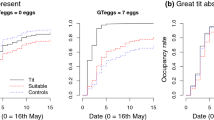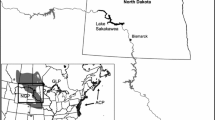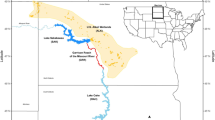Abstract
Natal dispersal allows individuals to reach suitable breeding sites. The effect of present plant phenology as a cue for dispersal into areas with favourable stages of development has been well established across avian and mammalian taxa. However, the effect of past experience is less understood. We studied the effect of past and present phenology of the environment on the direction and distance of natal dispersal in a passerine bird, the pied flycatcher (Ficedula hypoleuca). We monitored spring settlement of local recruits in six nest box plots along a 10-km stretch of a south-north gradient of plant and caterpillar food development. We found that males used both past experience of caterpillar phenology from early life and actual plant phenology during the recruitment season as independent cues for breeding settlement. Males that had experienced a mismatch with the caterpillar food peak as a nestling, and/or those that arrived late in the spring in the recruitment year, moved north of their natal site, whereas males that had experienced a better match with the caterpillars as a nestling, and/or those that migrated earlier in the spring, settled at a similar site or more to the south. In females, no such effects were found, suggesting that the usage of phenological cues is sex specific. In summary, tracking environmental phenology by natal dispersal may represent an effective mechanism for settling in new favourable areas, and may thus potentially cause rapid change of a species’ geographical breeding range in response to climate change.



Similar content being viewed by others
References
Alatalo RV, Lundberg A, Björklund M (1982) Can the song of male birds attract other males—an experiment with the pied flycatcher Ficedula hypoleuca. Bird Behav 4:42–45
Alatalo RV, Lundberg A, Glynn C (1986) Female pied flycatchers choose territory quality and not male characteristics. Nature 323:152–153
Arcese P (1989) Intrasexual competition, mating system and natal dispersal in song sparrows. Anim Behav 38:958–979
Benard MF, McCauley SJ (2008) Integrating across life-history stages: consequences of natal habitat effects on dispersal. Am Nat 171:553–567
Berndt R, Winkel W (1979) Verfrachtungs-Experimente zur Frage der Geburtsortspragung beim Trauerschnapper (Ficedula hypoleuca). J Ornithol 120:41–53
Bitume EV, Bonte D, Magalhaes S, Martin GS, Van Dongen S, Bach F, Anderson JM, Olivieri I, Nieberding CM (2011) Heritability and artificial selection on ambulatory dispersal distance in Tetranychus urticae: effects of density and maternal effects. PLoS ONE 6:e26927. doi:10.1371/journal.pone.0026927
Both C, van Asch M, Bijlsma RG, van den Burg AB, Visser ME (2009) Climate change and unequal phenological changes across four trophic levels: constraints or adaptations? J Anim Ecol 78:73–83
Both C, Robinson RA, van der Jeugd HP (2012) Long-distance dispersal in migratory pied flycatchers Ficedula hypoleuca is relatively common between the UK and the Netherlands. J Avian Biol 43:193–197
Brommer JE (2008) Extent of recent polewards range margin shifts in Finnish birds depends on their body mass and feeding ecology. Ornis Fenn 85:109–117
Burger C, Belskii E, Eeva T, Laaksonen T, Mägi M, Mänd R, Qvarnström A, Slagsvold T, Veen T, Visser ME, Wiebe KL, Wiley C, Wright J, Both C (2012) Climate change, breeding date and nestling diet: how temperature differentially affects seasonal changes in pied flycatcher diet depending on habitat variation. J Anim Ecol 81:926–936
Campbell SP, Witham JW, Hunter ML (2010) Stochasticity as an alternative to deterministic explanations for patterns of habitat use by birds. Ecol Monogr 80:287–302
Charmantier A, McCleery RH, Cole LR, Perrins C, Kruuk LEB, Sheldon BC (2008) Adaptive phenotypic plasticity in response to climate change in a wild bird population. Science 320:800–803
Clobert J, Danchin E, Dhondt AA, Nichols JD (2001) Dispersal. Oxford University Press, New York
Cody ML (1985) Habitat selection in birds. Academic Press, Orlando
Cresswell W, McCleery R (2003) How great tits maintain synchronization of their hatch date with food supply in response to long-term variability in temperature. J Anim Ecol 72:356–366
Crick HQP (2004) The impact of climate change on birds. Ibis 146:48–56
Dale S, Slagsvold T (1995) Female contests for nest sites and mates in the pied flycatcher Ficedula hypoleuca. Ethology 99:209–222
Dale S, Slagsvold T (1996) Mate choice on multiple cues, decision rules and sampling strategies in female pied flycatchers. Behaviour 133:903–944
Dale S, Rinden H, Slagsvold T (1992) Competition for a mate restricts mate search of female pied flycatchers. Behav Ecol Sociobiol 30:165–176
Dhondt AA (1979) Summer dispersal and survival of juvenile great tits in southern Sweden. Oecologia 42:139–157
Dias PC, Blondel J (1996) Breeding time, food supply and the fitness components of blue tits Parus caeruleus in Mediterranean habitats. Ibis 138:644–649
Doligez B, Danchin E, Clobert J (2002) Public information and breeding habitat selection in a wild bird population. Science 297:1168–1170
Duckworth RA, Badyaev AV (2007) Coupling of dispersal and aggression facilitates the rapid range expansion of a passerine bird. Proc Natl Acad Sci USA 104:15017–15022
Durant JM, Hjermann DØ, Ottersen G, Stenseth NC (2007) Climate and the mismatch or mismatch between predator requirements and resource availability. Clim Res 33:271–283
Fischbacher M, Naef-Daenzer B, Naef-Daenzer L (1998) Estimating caterpillar density on trees by collection of frass droppings. Ardea 86:121–129
Fraser DF, Gilliam JF, Daley MJ, Le AN, Skalski GT (2001) Explaining leptokurtic movement distributions: intrapopulation variation in boldness and exploration. Am Nat 158:124–135
Fretwell SD, Lucas HL (1969) On territorial behavior and other factors influencing habitat distribution in birds. 1. Theoretical development. Acta Biotheor 19:16–36
Garant D, Kruuk LEB, Wilkin TA, McCleery RH, Sheldon BC (2005) Evolution driven by differential dispersal within a wild bird population. Nature 433:60–65
García-Navas V, Sanz JJ (2011) The importance of a main dish: nestling diet and foraging behaviour in Mediterranean blue tits in relation to prey phenology. Oecologia 165:639–649
Hanski I (2001) Population dynamics consequences of dispersal in local populations and in metapopulations. In: Clobert J, Danchin E, Dhondt AA, Nichols JD (eds) Dispersal. Oxford University Press, New York, pp 283–299
Hildén O (1965) Habitat selection in birds. Ann Zool Fenn 2:53–75
Ims RA, Hjermann DØ (2001) Condition-dependent dispersal. In: Clobert J, Danchin E, Dhondt AA, Nichols JD (eds) Dispersal. Oxford University Press, New York, pp 203–217
Lampe HM, Espmark YO (2003) Mate choice in pied flycatchers Ficedula hypoleuca: can females use song to find high-quality males and territories? Ibis 145:E24–E33
Lauscher A, Lauscher F, Printz H (1955) Die Phänologie Norwegens. Skr Norske Vidensk—Akad Mat-Naturv Kl: 1–99
Leech DI, Crick HQP (2007) Influence of climate change on the abundance, distribution and phenology of woodland bird species in temperate regions. Ibis 149:128–145
Lundberg A, Alatalo RV (1992) The pied flycatcher. Poyser, London
Matthysen E, Adriaensen F, Dhondt AA (2011) Multiple responses to increasing spring temperatures in the breeding cycle of blue and great tits (Cyanistes caeruleus, Parus major). Glob Change Biol 17:1–16
Naef-Daenzer B, Keller LF (1999) The foraging performance of great and blue tits (Parus major and P. caeruleus) in relation to caterpillar development, and its consequence for nestling growth and fledging weight. J Anim Ecol 68:708–718
Nilsson J-Å (1989) Causes and consequences of natal dispersal in the marsh tit, Parus palustris. J Anim Ecol 58:619–663
Orians GH, Wittenberger JF (1991) Spatial and temporal scales in habitat selection. Am Nat 137:S29–S49
Paradis E, Baillie SR, Sutherland WJ, Gregory RD (1998) Patterns of natal and breeding dispersal in birds. J Anim Ecol 67:518–536
Parmesan C (2006) Ecological and evolutionary responses to recent climate change. Annu Rev Ecol Evol Syst 37:637–669
Parmesan C, Root TL, Willig MR (2000) Impacts of extreme weather and climate on terrestrial biota. Bull Am Meteorol Soc 81:443–450
Pärt T (1990) Natal dispersal in the collared flycatcher: possible causes and reproductive consequences. Ornis Scand 21:83–88
Partridge L (1974) Habitat selection in titmice. Nature 247:573–574
Partridge L (1976) Field and laboratory observations on foraging and feeding techniques of blue tits (Parus caeruleus) and coal tits (Parus ater) in relation to their habitats. Anim Behav 24:534–544
Pasinelli G, Schiegg K, Walters JR (2004) Genetic and environmental influences on natal dispersal distance in a resident bird species. Am Nat 164:660–669
Pinheiro J, Bates D, DebRoy S, Sarkar D, R Development Core Team (2013) nlme: linear and nonlinear mixed effects models. R package 3.1-108
Piper WH (2011) Making habitat selection more “familiar”: a review. Behav Ecol Sociobiol 65:1329–1351
Potti J, Montalvo S (1991) Return rate, age at first breeding and natal dispersal of pied flycatchers Ficedula hypoleuca in Central Spain. Ardea 79:419–428
R Core Team (2012) R: a language and environment for statistical computing. R Foundation for Statistical Computing, Vienna. http://www.R-project.org
Reed TE, Jenouvrier S, Visser ME (2013) Phenological mismatch strongly affects individual fitness but not population demography in a woodland passerine. J Anim Ecol 82:131–144
Ronce O (2007) How does it feel to be like a rolling stone? Ten questions about dispersal evolution. Annu Rev Ecol Evol Syst 38:231–253
Rosenzweig C, et al. (2008) Attributing physical and biological impacts to anthropogenic climate change. Nature 453:353–357
Schmidt KA, Whelan CJ (2010) Nesting in an uncertain world: information and sampling the future. Oikos 119:245–253
Schwartz MD (2003) Phenology: an integrative environmental science. Kluwer, Dordrecht
Seppänen JT, Forsman JT, Mönkkönen M, Krams I, Salmi T (2011) New behavioural trait adopted or rejected by observing heterospecific tutor fitness. Proc R Soc Lond B 278:1736–1741
Siikamäki P (1998) Limitation of reproductive success by food availability and breeding time in pied flycatchers. Ecology 79:1789–1796
Skogland T (1980) Comparative summer feeding strategies of arctic and alpine Rangifer. J Anim Ecol 49:81–98
Slagsvold T (1986) Nest site settlement by the pied flycatcher: does the female choose her mate for the quality of his house or himself. Ornis Scand 17:210–220
Slagsvold T, Eriksen A, de Ayala R, Husek J, Wiebe KL (2013) Post-fledging movements in birds: do tit families track environmental phenology? Auk 130:36–45
Sokal RR, Rohlf FJ (1995) Biometry, 3rd edn. Freeman, New York
Stamps JA (2001) Habitat selection by dispersers: integrating proximate and ultimate approaches. In: Clobert J, Danchin E, Dhondt AA, Nichols JD (eds) Dispersal. Oxford University Press, New York, pp 230–243
Stamps JA, Krishnan VV (1999) A learning-based model of territory establishment. Q Rev Biol 74:291–318
Starrfelt J, Kokko H (2010) Parent-offspring conflict and the evolution of dispersal distance. Am Nat 175:38–49
Studds CE, Kyser TK, Marra PP (2008) Natal dispersal driven by environmental conditions interacting across the annual cycle of a migratory songbird. Proc Natl Acad Sci USA 105:2929–2933
Thingstad PG (2001) Ageing nestlings of the pied flycatcher. Ornis Norveg 24:60–63
Tilgar V, Mand R, Kilgas P, Magi M (2010) Long-term consequences of early ontogeny in free-living great tits Parus major. J Ornithol 151:61–68
Tinbergen JM, Dietz MW (1994) Parental energy expenditure during brood rearing in the great tit (Parus major) in relation to body mass, temperature, food availability and clutch size. Funct Ecol 8:563–572
Tonnis B, Grant PR, Grant BR, Petren K (2005) Habitat selection and ecological speciation in Galapagos warbler finches (Certhidea olivacea and Certhidea fusca). Proc R Soc Lond B 272:819–826
Vallin N, Qvarnström A (2011) Learning the hard way: imprinting can enhance enforced shifts in habitat choice. Int J Ecol (Article ID 287532)
van Balen JH (1973) A comparative study of the breeding ecology of the great tit Parus major in different habitats. Ardea 61:1–93
van Balen JH (1979) Observations on the post-fledging dispersal of the pied flycatcher, Ficedula hypoleuca. Ardea 67:134–137
van der Wal R, Madan N, Van Lieshout S, Dormann C, Langvatn R, Albon SD (2000) Trading forage quality for quantity? Current plant phenology and patch choice by Svalbard reindeer. Oecologia 123:108–115
van Noordwijk AJ, McCleery RH, Perrins CM (1995) Selection for the timing of great tit breeding in relation to caterpillar growth and temperature. J Anim Ecol 64:451–458
Vatka E, Orell M, Rytkönen S (2011) Warming climate advances breeding and improves synchrony of food demand and food availability in a boreal passerine. Glob Change Biol 17:3002–3009
Veen T, Sheldon BC, Weissing FJ, Visser ME, Qvarnström A, Saetre GP (2010) Temporal differences in food abundance promote coexistence between two congeneric passerines. Oecologia 162:873–884
Verboven N, Tinbergen JM, Verhulst S (2001) Food, reproductive success and multiple breeding in the great tit Parus major. Ardea 89:387–406
Verhulst S, Perrins CM, Riddington R (1997) Natal dispersal of great tits in a patchy environment. Ecology 78:864–872
Visser ME, van Noordwijk AJ, Tinbergen JM, Lessells CM (1998) Warmer springs lead to mistimed reproduction in great tits (Parus major). Proc R Soc Lond B 265:1867–1870
Visser ME, Holleman LJM, Gienapp P (2006) Shifts in caterpillar biomass phenology due to climate change and its impact on the breeding biology of an insectivorous bird. Oecologia 147:164–172
von Haartman L (1956) Territory in the pied flycatcher Muscicapa hypoleuca. Ibis 98:460–475
Walther GR, Post E, Convey P, Menzel A, Parmesan C, Beebee TJC, Fromentin JM, Hoegh-Guldberg O, Bairlein F (2002) Ecological responses to recent climate change. Nature 416:389–395
Wood SN (2006) Generalized additive models: an introduction with R. Chapman & Hall, Boca Raton
Acknowledgments
We thank T. A. Grønbech, A. Herland, C. Eriksen, J. Heimvåg, S. Dreyer, M. Andersen, M. Godvindoorazoo, E. Bernard, D. Hope, A. Eriksen, J. Skjerven, K. Cimadom, A. Gahr for technical assistance at Dæli and Zinober plots. Comments from two anonymous reviewers greatly improved the manuscript. The study was supported by the Centre for Ecological and Evolutionary Synthesis, the Department of Biosciences, University of Oslo. The study was performed under licence from the Directorate for Nature Management (2009/3137 ART-VI-JAA), and from the National Animal Research Authority in Norway (FOTS ID 2542). The authors declare that they have no conflict of interest.
Author information
Authors and Affiliations
Corresponding author
Additional information
Communicated by Markku Orell.
Electronic supplementary material
Below is the link to the electronic supplementary material.
Rights and permissions
About this article
Cite this article
Hušek, J., Lampe, H.M. & Slagsvold, T. Natal dispersal based on past and present environmental phenology in the pied flycatcher (Ficedula hypoleuca). Oecologia 174, 1139–1149 (2014). https://doi.org/10.1007/s00442-013-2842-1
Received:
Accepted:
Published:
Issue Date:
DOI: https://doi.org/10.1007/s00442-013-2842-1




